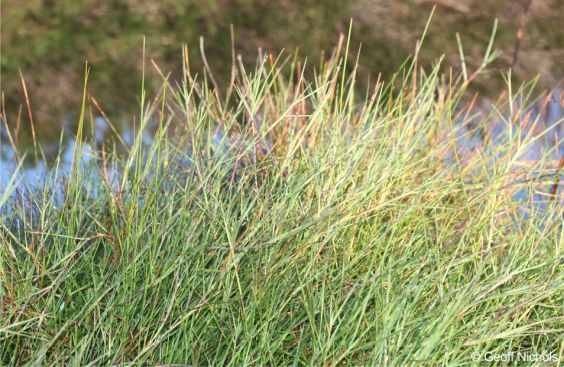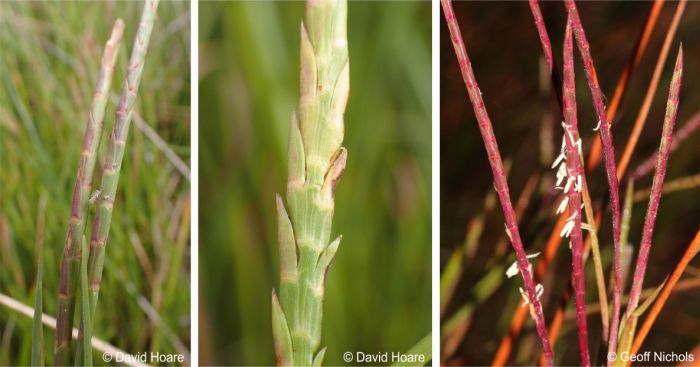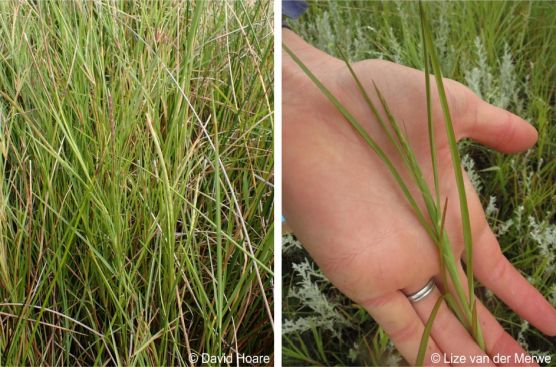Hemarthria altissima
Hemarthria altissima (Poir.) Stapf & C.E.Hubb
Family: Poaceae
Common names: red vlei grass, Batavian quick grass, red swamp grass, swamp couch (Eng.); Bataviese kweek, perdegras, perdekweek, rooikweek, rooivleigras (Afr.); marotlo-a-mafebelu, mohlokxorima, namele, tajoe (Sesotho)
Introduction
Red vlei grass can be recognised easily from other grasses, because the whole plant has a distinctive rust-red colour. It has a mat forming habit, which is why it is commonly called a couch or kweek grass.

Description
Description
Hemarthria altissima is a rust-red perennial, 300–1 500 mm high, mat-forming; rhizomes and stolons present. Leaf blade is 50–150 × 6 mm, flat, becoming twisted like a corkscrew when old. Inflorescence is culm-like, raceme very narrowly cylindrical, 3–6 mm long. Sessile spikelet is 4–7 mm long; lower glume obtuse to emarginate; upper glume obtuse to acute; callus triangular; anther 2.4–3.0 mm long. Pedicelled spikelet is without a callus. Hemarthria altissima flowers during summer, from October to June.

Conservation Status
Status
The current status of Hemarthria altissima, according to the South African National Biodiversity Institute (SANBI) Red list of South African plants, has been assessed as Least Concern (LC). Red vlei grass is widespread and common and is not in danger of extinction.
Distribution and habitat
Distribution description
Hemarthria altissima is mainly found in southern tropical Africa, Madagascar, the Mediterranean region and southeast Asia. It is introduced to the United States of America (USA). In South Africa, Hemarthria altissima occurs in Limpopo, North West, Gauteng, Mpumalanga, Free State, KwaZulu-Natal and the Northern, Western and Eastern Cape Provinces, but is infrequent in the Karoo, Karroid and Kalahari areas. It also found in Namibia, Botswana, Lesotho and Eswatini (formerly Swaziland). Red vlei grass grows in wet or damp places such as vleis and along river banks and even in open water. It is also grows in any type of soil, particularly in granite areas.

Derivation of name and historical aspects
History
The genus name Hemarthria is derived from the Greek words hemi meaning half and arthron meaning joint, thus half jointed, alluding to the resistance of the raceme joints to breaking. The species name altissima is a Latin word, meaning ‘highest’, but the reason for the name is unknown. The genus Hemarthria has 12 species which are mainly found in tropical and subtropical regions of the Old World, also in America. There is just one species in southern Africa, Hemarthria altissima, which is widespread.
Ecology
Ecology
Hemarthria altissima is found in wet places, vleis and river margins. It is a good grazing grass. This grass is the first grass to initiate growth after a frost or freeze. In autumn and early spring, this grass produces more biomass than other warm-season grasses. Red vlei grass can withstand short seasonal dry periods, but does not tolerate long droughts. It does not tolerate burning.

Uses
Use
Red vlei grass is a palatable grazing grass with a high leaf production and it is used as a cultivated pasture in some countries, for example, in America (Florida) where it is known as ‘Limpo grass’, an abbreviation for Limpopo, because that is where it was probably first collected. It is one of the earliest vlei grasses to grow out in the spring. In Lesotho children are said to eat the raw rhizome and the stems are plaited into ropes used to bind the reeds forming the enclosure round a courtyard. It is regarded as a ruderal weed in some places.
Growing Hemarthria altissima
Grow
Hemarthria altissima seed production is low, but the long, decumbent stems root readily at the nodes making vegetative propagation through sprigging an accepted commercial practice. It is propagated by cuttings planted into wet soil, early in the season if unfrosted planting material is available, or in late summer having allowed a build-up of planting material during the peak season. It appears to give more successful establishment results if the cutting nursery is fertilized with nitrogen 2‒3 weeks before harvest. Freshly mowed stems and stolons of 2- to 3-month old grass are spread over a well-prepared seedbed, partially covered with a disk harrow and rolled to compact the soil around the cuttings. Planting rates of 1 t/ha vegetative material are recommended on "clean" ground or 1.5‒2 t/ha if weeds or other grass are likely to compete. Livestock should be withheld until the grass is established, even cutting and conserving the initial growth flush to ensure establishing plants are not pulled out. When the grass reaches 10 cm or more high, susceptible weeds can be controlled with dicamba. Broadleaf herbicides should not be used for weed control if legumes are planted with the grass.
References
- Chippindall, L.K.A. & Crook, A.O. 1976. Grasses of southern Africa. Collins, Harare.
- Fish, L., Mashau, A.C., Moeaha, M.J. & Nembudani, M.T. 2015. Identification guide to southern African grasses. Strelitzia 36: 271–276. South African National Biodiversity Institute, Pretoria.
- Hoare, D. 2025. Observation of Hemarthria altissima, John Taolo Gaetsewe District Municipality, Northern Cape. iNaturalist. Online. https://www.inaturalist.org/observations/263603669.
- Leistner, O.A. (ed.). 2000. Seed plants of southern Africa: families and genera. Strelitzia 10. National Botanical Institute, Pretoria.
- Newman, Y.C., Vendramini, J.M.B., Sollenberger, L.E. & Quesenberry, K.H. 2014. Limpograss (Hemarthria altissima): Overview and Management. SS-AGR-320. Agronomy Department, Institute for Food and Agricultural Sciences, University of Florida, Gainesville.
- Nichols, G. 2025. Observation of Hemarthria altissima, NWSMA Nuwejaars River, Western Cape. iNaturalist. Online. https://www.inaturalist.org/observations/164385074.
- Van der Merwe, L. 2025. Observation of Hemarthria altissima, Good Hope Forestry Estate, KZN. iNaturalist. Online. https://www.inaturalist.org/observations/20164104.
- Van Oudtshoorn, F. 1999. Guide to the grasses of southern Africa. Briza Publications, Pretoria.
- Von Staden, L. 2020. Hemarthria altissima (Poir.) Stapf & C.E.Hubb. National Assessment: Red List of South African Plants. https://redlist.sanbi.org/species.php?species=1180-1.
Credits
Dr. Aluoneswi Caroline Mashau
National Herbarium, Pretoria
August 2025
Acknowledgements: images by David Hoare, Geoff Nichols and Lize van der Merwe from their observations uploaded on iNaturalist.
Plant Attributes:
Plant Type: Grass
SA Distribution: Eastern Cape, Free State, Gauteng, KwaZulu-Natal, Limpopo, Mpumalanga, North West, Northern Cape, Western Cape
Soil type: Sandy, Clay, Loam, Brack/saline, Metal-rich
Flowering season: Early Summer, Late Summer, Autumn, Winter
PH:
Flower colour: Green
Aspect: Full Sun
Gardening skill: Easy
Special Features:
Horticultural zones











Rate this article
Article well written and informative
Rate this plant
Is this an interesting plant?
Login to add your Comment
Back to topNot registered yet? Click here to register.